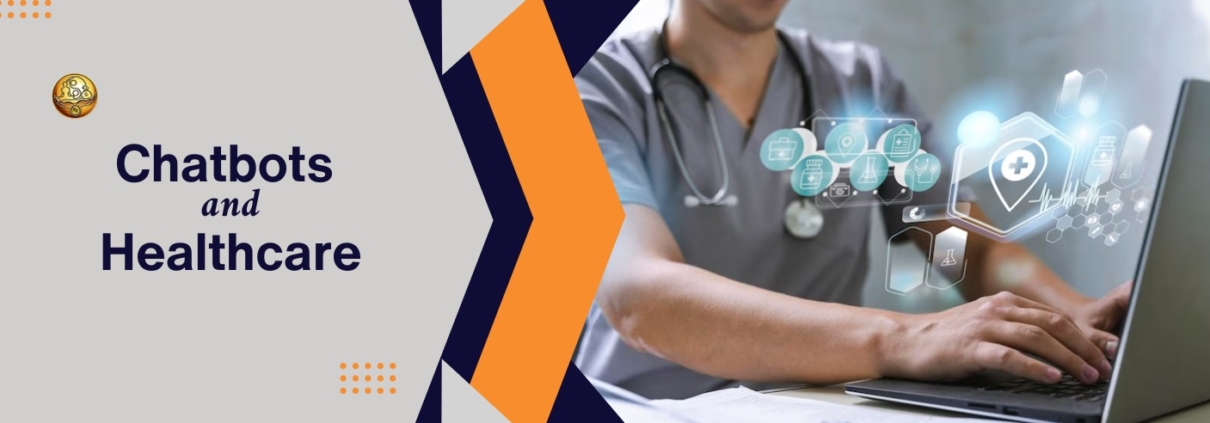Chatbots are remodeling healthcare with the aid of using revolutionizing affected person engagement. These AI-powered conversational agents streamline administrative tasks, deliver personalized support, and reshape the healthcare experience.
Find out how they affect making appointments, reminding people to take their medications, sorting symptoms, and getting reliable health information. This blog explores the benefits, challenges, and future potential of chatbot technology in improving patient care and outcomes.
Understanding Chatbots in Healthcare
Chatbots are becoming more and more important in the healthcare business. This is because of the COVID-19 pandemic, which caused a rise in the need for medical care, and the improvement of the artificial intelligence (AI) that powers the technology.
As has been widely reported, the pandemic has made it so that there are a lot of patients and a lot of paperwork for doctors and nurses, but at the same time, people have less access to healthcare because of quarantines and social distance. A few years ago, some parts of the healthcare industry started using chatbots, also called “conversational assistants,” to remind patients to take their medicine, collect insurance or health information, or give pretty general information about disease symptoms, nutrition, or treatments.
The COVID-19 pandemic has given the health care business even more chances to use chatbots. These include making it easier for patients to fill out paperwork at doctors’ offices, setting up appointments, giving mental support to people who are in quarantine, and even helping patients decide if their COVID-19-like symptoms are serious enough to warrant a trip to the doctor.
Early chatbots used pre-written conversation and didn’t do well when users went off script. Today’s chatbots, on the other hand, use AI to get better the more they are used. Natural language processing (NLP) is a key part of AI chatbots. It lets a robot better understand a patient’s written or spoken questions and pull out important information from the conversation.
In the past few years, virtual helpers and conversational chatbots driven by artificial intelligence (AI) have become very popular. They can be found in hospitals, labs, pharmacies, and even nursing homes. And with good cause. In this age of digital customer experience, people expect transactions to be quick and easy. In fact, a large study by Verified Market Research found that the healthcare chatbot market is worth USD 194.85 Million in 2021 and is expected to hit USD 943.64 Million by 2030, growing at a CAGR of 19.16% from 2022 to 2030.
Benefits of Chatbots in Healthcare
Chatbots allow healthcare organizations to reach more people by letting them have interactive talks that can help find symptoms, manage medications, and keep an eye on long-term health problems. At this point, the goal of virtual assistants is not to fully diagnose patients. Instead, the goal is to help patients find the right tools and help doctors and nurses better understand what a patient needs.
The following are some of the benefits that healthcare apps offer both doctors and their patients:
- Chatbots are always and immediately available. This includes having access to medical information 24 hours a day, 7 days a week, and getting instructions to take medications.
- They make it easy to get to health records quickly. Chatbots can help groups and patients keep track of records by getting information from patients and updating them right away. So, doctors and nurses can get the latest information and better plan how to care for their patients.
- They know a lot of languages. Many patients and potential patients can communicate with chatbots in their own languages, and the chatbots can then translate what they say for the doctors and nurses. Chatbots can help reach groups that don’t get enough help.
- They can be counted on. Chatbots are a better and more reliable option to online searches that patients do to try to figure out what’s wrong with them.
- They are good value for money. Juniper Research found in a 2018 report that if chatbots were used in retail, banking, and healthcare, businesses would save $11 billion per year by 2023, mostly because they would spend less time on customer and patient service questions.
Applications of Chatbots in Healthcare
Here are some of the most common applications of chatbots in the healthcare industry:
1. Set up Appointments
The chatbot can designate a doctor, contact the doctor with patient details, and create a space in both the patient’s and the doctor’s schedule. This makes online appointment scheduling easy for patients.
2. Check Symptoms
Healthcare chatbots can instantly assess symptoms and severity. The chatbot then estimates a diagnosis and suggests treatments. Patients don’t have to re-enter their information when updating because the chatbot remembers it. This function lets patients easily assess symptoms, measure severity, and get individualized advice.
3. Provide Support
Healthcare chatbots can handle common patient questions. Healthcare practitioners can focus on more difficult concerns with an intelligent chatbot answering these questions. Chatbots can also provide patient information.
4. Insurance and Claims
Chatbots can simplify medical claims and save patients time. Healthcare chatbots can help patients file claims, check coverage, and track claims using natural language. Patients may easily access essential information and avoid repeated calls to healthcare providers. Doctors can also use healthcare chatbots to pre-authorize billing payments and other requests from patients or healthcare authorities by accessing patient information and enquiries.
5. Improving Patient Experience
Chatbots make doctors available 24/7. Chatbots can help patients and answer their questions 24/7 with a 99.9% uptime.
6. Help with Therapy
Psychiatric patients can get help from therapist robots. These chatbots help out qualified professionals in mental health. Cognitive behavioral treatment can be done by chatbots that can have conversations.
7. Prescriptions
Healthcare chatbots urge patients to take their meds and track their compliance. They can also explain prescription adverse effects and precautions.
Challenges and Considerations
Some of the problems that come up when healthcare workers use a chatbot.
Giving the Wrong Medical Information
There is a chance that a robot could give the wrong information about health care. The main reason for this is that robots might not know enough about a patient’s medical problem and could give a dangerously wrong diagnosis.
Weaknesses in User Privacy
When hospitals use AI chatbots for healthcare, this software tool gets all the information from the patients and stores it. If there are security problems that lead to a cyberattack, the patient’s information could get into the wrong hands.
The Lack of In-Person Contact
There are some people who wouldn’t want to talk to a bot about their health problems. They might want to talk to the doctor in person. But now that robots are around, this has become a very big problem. This makes the patient feel bad, which hurts their health in the long run. So, chatbots are one reason why people feel like they aren’t connected to their doctors and nurses.
The Future of Chatbots for Healthcare
Conversational AI is still in its early stages and has a long way to go before it can be fully used in business. This is one of the main things that makes it hard for chatbot technology to catch on. With more time and training, these health bots will get better at what they do and be able to take on more tasks, which will help the industry accept them.
But here are some real hopes for the future of these health chatbots:
- Soon, they will be able to check on people’s health in real time and automatically send help requests during a crisis, just like gadgets can check on people’s health while they’re on the go.
- They will help people deal with long-term health problems, mental health issues, and fitness issues. They will also help control behavioral and mental disorders.
- Most diseases that are common today could have been stopped if they had been found early. Early detection helps stop further damage to your body before it happens. Soon, healthcare chatbots will be able to help find symptoms ahead of time, check a patient’s medical background, look for similar cases from the past, and suggest the best course of action for the future.
- Chatbots can be used as virtual helpers and help people take care of themselves.
Conclusion
Chatbots are transforming healthcare by revolutionizing patient engagement. From streamlining administrative tasks to delivering personalized support, these AI-powered conversational agents offer numerous benefits. To explore more about the applications and benefits of chatbots in healthcare, visit our website at ERPS Group. Discover how chatbots can revolutionize your healthcare practice and enhance patient experiences. Embrace the future of patient engagement with chatbot technology.
Frequently Asking Questions:
1.How are chatbots used in healthcare?
Answer: A well-made healthcare chatbot can schedule meetings based on when the doctor is free. Also, chatbots can be set up to talk to CRM systems so that they can help medical staff keep track of patient visits and follow-up meetings and have the information ready to use in the future.
2.How can chatbots improve healthcare?
Answer: Adding a chatbot to the care you give your patients – Capacity
Chatbots in healthcare make it easy for people to get health information and services. Patients can talk to clever bots in a way that feels natural to them. And that makes it natural to ask questions and look for answers. This can make people feel like they have a bigger say in how their health care is run.
3. What is an example of a health care chatbot?
Answer: GYANT is a health chatbot that asks people about their complaints and then sends that information to doctors, who use it to make diagnoses and give medicine right away.
4. Which algorithm is used for healthcare chatbots?
Answer: The SVM algorithm is used in several medical robots because it works with data that can be separated in a linear way. Kernel functions are used for data that can’t be separated in a linear way.
5. What are the top chatbots examples?
Answer: 26 Best Real Life Chatbot Examples
The best chatbot examples in 2022 are:
- Lyro customer support AI.
- Kuki AI Companion.
- Meena by Google.
- BlenderBot by Facebook.
- Rose AI Chatbot.
- Replika: AI Friend.
- Eviebot by Existor.
- Tay by Microsoft.





Leave a Reply
Want to join the discussion?Feel free to contribute!